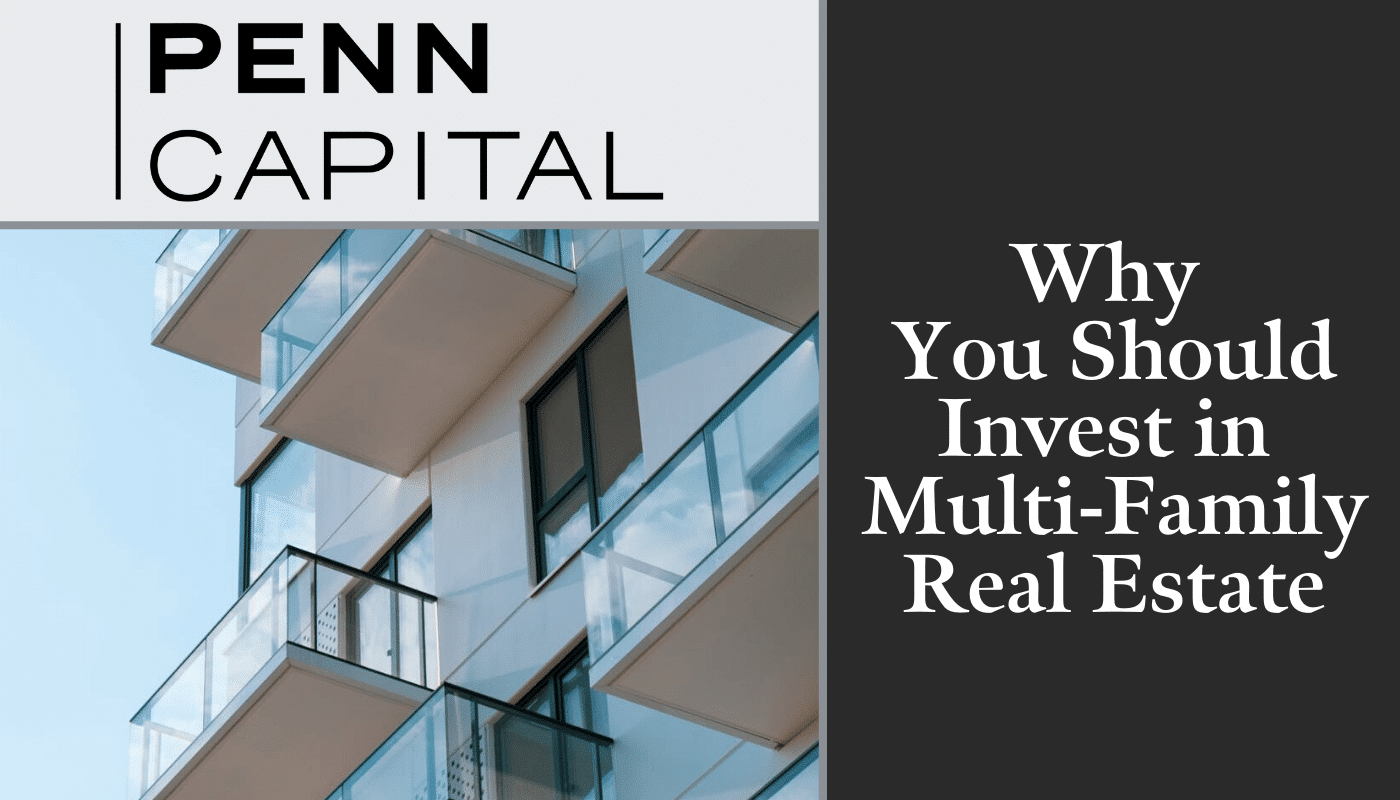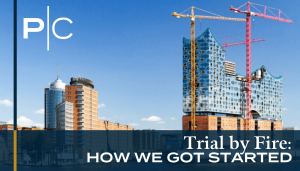Why You Should Invest in Multi-Family Real Estate
By Ed Rogan, Owner, Co-Founder

Multi-family real estate is a subsection of commercial real estate (CRE). These are any properties with 5+ residential units, most commonly apartment buildings. Investing in multi-family can be a great way to diversify your investment portfolio.
Every asset class has its own benefits for different investors. Multi-family is no exception, with benefits that might be attractive to some investors and not to others. First, a little basic background on how it all works.
How Multi-Family Investment Works
- LLC with GPs (sponsor) & LPs (equity partners, investors)
- Passive income/losses
In most cases, multi-family investment properties are purchased by a single purpose entity, like an LLC, that is set up exclusively for the purpose of buying and owning a single property. This LLC is managed by a sponsor who finds a great property, invests some of the money, and searches for capital from outside investors. Because of the high cost of larger multi-family properties, outside investment is very common.
Many multi-family investment LLCs are structured with the sponsor(s) as general partner (GP) and any outside investors coming in as limited partners (LPs). As the GP, a sponsor is responsible for management of everything while LPs are only responsible for providing initial capital in exchange for equity. The GP is generally liable for the performance of the project and to the bank for the debt, as well as for any capital they contribute to the projet, while the LPs are at risk only for the equity they invest (hence the term ‘limited’ partners).
As an LP, you’ll experience everything beneficial that multi-family has to offer while enjoying considerable less risk and time commitment than the GP.
Benefits of MFR
Compared to single family real estate, traditional assets, or other branches of commercial real estate like office buildings or retail space, multi-family has a few distinct benefits. It’s a unique asset class that works well for many passive investors.
Here we’ll look at the four main benefits of multi-family real estate as an investment property.
1. Physical Asset with Equity
Multi-family real estate is a physical asset that you can see and feel. This is true for any real estate asset, but it’s a marked difference from other assets like bonds, stocks, or mutual funds.
Having a physical asset reduces your investment liquidity, but also gives you some stability if the market fluctuates too much. Your money is more secure within a physical asset because, provided there is income being generated and debt isn’t too high,the benefit of being relatively illiquid is that it’s a lot more stable than liquid stocks and bonds that can be traded in an instant during sudden market crashes.
2. Actively Manage Property Price
- Making changes that affect the NOI by increasing rent or decreasing expenses
- Value of MFR is based on NOI/cap rate
- “Forced appreciation”
Multi-family real estate has a unique model of valuation. It’s directly related to the net operating income (NOI) of the property. Take the NOI and divide it by the cap rate to get the value of the building.
For example, a 100-unit property with an NOI of $100,000 and a cap rate of 5% would be valued as follows:
100,000 / 0.05 = $2,000,000
It’s a simple valuation system that leaves the value of the property entirely in your hands because you have the ability to force appreciation of the asset by improving your NOI.
In the above example, let’s assumes there’s an NOI of $1,000 on average per unit per year. If you reduce expenses or increase revenue from your units and add an extra $50 to the unit average annually, you’re going to positively impact the valuation. The math would look like this:
$1050 x 100 units = $105,000
105,000 / 0.05 = $2,100,000
From the $5,000 increase in annual NOI, you gain $100,000 of value on the property in this example.
There are many different ways to impact your NOI, which gives you options when you’re choosing an investment property. Find something available that’s running below market averages, then work on increasing revenues while lowering your expenses to get a net benefit.
Increasing Income
Income increases come in different forms. The most obvious way to increase income is to increase the rent, but that’s not always possible in every unit. If the units are older or already priced competitively, you don’t have much room to up the rent.
Consider alternative revenue streams. Depending on the property, you have different options, including:
• Passing utility costs to tenants
• Charging parking fees
• Offering extra services like storage or laundry facilities
• Buying bulk renter’s insurance plans and re-selling them to tenants
• Offering discounted service connections like cable or internet connectivity
All these activities would have a positive impact on your revenues, which will consequently improve NOI and increase valuation (all other things remaining equal).
Reducing Expenses
NOI can be improved by lowering your operating expenses. With most multi-family properties there’s more wiggle room in the expenses than you might expect. It takes a critical eye to find the excess, but it’s worth correcting to improve your valuation.
Look out for these types of expense reduction opportunities:
• Correcting overstaffing, appropriate labor management for each building individually
• Working with leasing personnel to reduce vacancies
• Renegotiating expenses provided by outside vendors (trash, landscaping, etc.) – bonus tip: if you own more than one multi-family property in the same area, take advantage of economies of scale with your vendors
• Reduce water consumption in landscaping
• Install energy efficient lighting in common areas
Often, reducing expenses takes some creativity on your part. You have to find a way to reduce your expenses without ruining the property, or cutting services and upsetting the tenants themselves. It’s a delicate balance, but there are viable possibilities.
Sign up to receive our educational newsletter and to gain exclusive access to our next investment opportunity.
3. Leveraging
When you’re purchasing a multi-family property, you’re getting a lot of units all at once. The more units you have, the higher your income potential is from that asset. As long as you can enough investment capital to appease a lender, you can leverage a larger property and maximize your earning potential.
With single family properties, you have to mortgage each property individually. The amount of time and capital investment to get 100 single family units is extensive. You may have to get 100 separate mortgages versus getting 100 units in a single building with one mortgage and one purchase.
Economies of scale works to your advantage. You can leverage debt to get more units and grow your portfolio faster. The more debt you have access to, the more units you’ll be able to get at once in a single property – while being cautious, of course, on not overleveraging and putting the asset at risk during an economic downturn.
4. Tax Advantages
Multi-family offers a lot of great tax benefits for investors. One of the most obvious benefits is the structure of depreciation. Depreciation is a tax code that acknowledges that real assets ‘decay’ over time and so from a tax perspective, the IRS allows deductions to be made from income to account for that. This means that real estate owners can keep more of the income each year than they would otherwise be able to because they can charge depreciation to their NOI as a deduction.
Average depreciation for multi-family assets is 27 years, but you can do a cost segregation study to accelerate that depreciation period for certain individual parts of the property. This has the potential to lower your tax burden even further.
Beyond the depreciation benefits, you have options for deferring rental income while you’re holding the asset, participating in a 1031 exchange upon sale of the building, or reducing your tax burden even further if you’re a real estate professional.
The specific benefits you stand to gain from are completely unique to your tax situation. You should consult with a tax professional that has specific knowledge about multi-family tax strategies.
Breaking into the Market
If you’re trying to go it alone, multi-family is a tough market to break into. You need to have a credible record for sellers to trust you enough on your offer and to believe that you will close on a deal. Multi-family deals close quickly, especially the best ones and as you’ll be responsible for bringing potentially millions of dollars to the table in a short period of time through investment or leverage, you’ll need to be properly prepared and have a good system in place to handle the volume and the velocity of the business.
Investing passively or with an existing sponsor is a great way to jump into multi-family without having to do all the legwork on your own. By partnering with other experienced investors, you get a leg up in the market, even if you’re just now starting out in the multi-family space.
RELATED ARTICLES
5 Keys to Investing in Distressed Real Estate
5 Keys to Investing in Distressed Real Estate By Ed Rogan, Owner, Co-Founder Buying distressed real estate certainly isn’t for the faint of heart. An inexperienced investor can easily be swayed by the promise of a project sponsor who doesn’t actually have a plan for turning the property around. But that doesn’t mean you shouldn’t…
READ MORE >Gaining an Edge through Cold Calling
Gaining an Edge through Cold Calling By Ed Rogan, Owner, Co-Founder In many ways, commercial real estate is an “eat what you can kill” industry. The most successful investors, developers, brokers and other CRE professionals earn their living by scouring the market to uncover the next big deal. Ask the industry’s best and they’ll often…
READ MORE >Trial by Fire: How We Got Started
Trial by Fire: How We Got Started By Ed Rogan, Owner, Co-Founder People often use the term “trial by fire” to explain how they learned something. In our case, the term is all too appropriate. Looking back on it, the story of how Percy and I got started almost seems unbelievable. We were just…
READ MORE >


